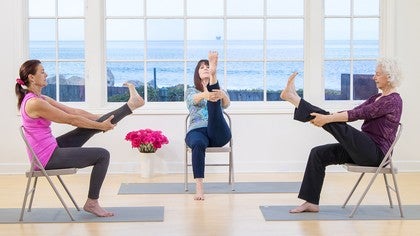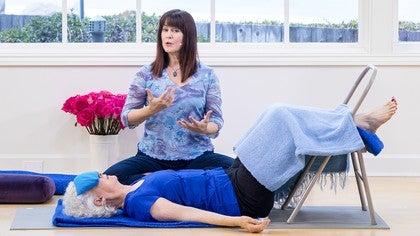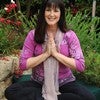Description
About This Video
Transcript
Read Full Transcript
(waves crashing) Namaste and welcome to Yin Yoga for caregivers. This is Francine; Francine I'm so glad that you could be with us today and to receive. Because it's so important to receive. Especially when you're care giving, when you're taking care of others whether in your job or in your life. It's very draining so it's really important to come back and fill the well and to nourish yourself.
Yin Yoga's a great way to do that and one thing that's wonderful about it is you don't need many props. So it's less prop intensive than the restorative practice so it really gives you this opportunity to, wherever you are, grab a couple of blankets, you may not even need that to do some of these poses. Yin Yoga's also wonderful for stretching some of the tightest areas in the body. The low back, the hips where the connective tissue is thickest and strongest, so it really brings great flexibility. But the other gift is that it really activates the flow of chi through the meridians and many of the poses, specifically are working with meridians in the body so activating and energizing your physical body.
So today we're gonna start with a pose that's called half butterfly. And I'll invite you to bend your knee, whichever knee feels the best, right knee. Good. And let it rest to the inner, it can be wherever it feels comfortable. It could be the inner knee, inner thigh.
And it can be nice to use your second blanket and place it to the outside edge of the leg and this helps to create a really nice amount of support for the hip and just make it a little more comfortable. Also she's sitting on a folded blanket and the folded blanket is really nice as well, for just helping to lift the hips a little bit, to rotate the pelvis forward a bit more when she moves in to the pose. So let's have you take a nice deep breath and just lift and lengthen up through the heart, through the crown of the head. Let your shoulders soften. Good and again, a nice breath, breathing deeply.
Feeling a nice lengthening through the spine. And as you exhale you can begin to come forward and find a position where the hands are relaxed, the arms are relaxed, and taking the first level of the pose. So the first level, I often think of it as baby steps, that we take these baby steps into the Yin poses. In part because we're holding the poses for longer so we're gonna have a nice amount of time in each pose to really give a chance for these tight places to stretch. So you can begin to just soften your body over the extended leg and close your eyes, and in this shape, notice what you feel.
By the way, if, per chance you have a hamstring injury, and this doesn't feel doable for you, you can bring the soles of your feet together and butterfly, and take butterfly instead which disengages the hamstrings so it's another choice that you can make here if that works best for your body. So as you're feeling into your body here just take a few moments to notice where there's tension and you can soften the areas like the shoulders, the neck, any place where the body wants to contract or hold and just let yourself soften. Feeling the breath washing through the tissues of the body. Take just a few more breaths here. You may have noticed that just naturally the pose deepened a bit.
Might feel a little bit easier. And then as you feel ready, slowly use your hands to walk up, and keep your eyes closed as you come back to a seated position. Draw the right knee naturally in towards your chest and sit tall for a moment with your right knee being held by your hands and just feeling the spine lengthening. And feel what happened, just close the eyes and take a moment. It's nice to not rush through the practice.
That just to feel the gifts of each posture and what it brings. And then when you feel ready, you can slowly extend your leg and draw the left knee in towards the chest. And then let it open out to the side, just a comfortable distance and you can position the blanket under the hip if it feels like it needs a little bit of support. And taking a moment to lengthen the spine here. Does that feel like it's supporting?
Yeah. So as you inhale, lift up through the heart, the crown of the head, just lengthening. Take a breath here, just feeling the spine growing long. This is important when we do forward folds is we activate the muscles and then we come forward. It helps the pelvis to also rotate forward.
And then just let your body soften, let your hands soften. The heart is moving towards that extended leg. And the leg's relaxed, the foot's relaxed, everything's relaxed. One of the things about Yin Yoga is even the muscles stay in a relaxed state so we can target the connective tissue, the fascia. And then when you breath into your body, you can direct the breath to where it feels the most tight.
You can soften your neck and your shoulders, the base of the skull, all those places where tension can accumulate. Just about another minute or so here, taking a few deep breaths and feeling the nourishing breath flowing through you. Softening into the pull of gravity. As your feel ready to release from the pose you can take some deep breaths, transitioning very slowly out, walking your hands back and using your hands to support you as you slowly come up and draw the left knee into the chest. And sit tall, with your eyes closed for a moment, noticing the effects of the forward fold.
So forward bends are calming and cooling postures. They're good for releasing stress and they're wonderful for, also certainly for stretching the legs and the back side of the body, and one of the largest meridians, the bladder meridian. Good and now as you're ready, you're gonna come forward and on to your stomach here. So however that feels comfortable for you. And you'll be coming into sphinx pose so you can either lock the elbows onto the sticky mat or whatever position feels good.
Sometimes I find if there's a little part of me on the blanket it doesn't feel good and sometimes it feels good so you can find for you what works good. And feel the position of the legs, so you'll notice if the legs are closer together you'll feel more of an even stretch along the spine. And with the legs wider apart you're gonna feel more intensity in your low back. So you can choose which position through the legs work and feel the best for you. Then, couple things to remember, one is, if you have had recently a low back issue, this can be good for some disc issues, but if it's to strong, you can walk your elbows forward.
You're still gonna keep your arms about shoulder width apart, so it can be good actually to take a hold of your upper arms, make sure that you're about shoulder width apart, and then feel free to slide the elbows forward a little bit, and bring your ribs down to the blanket or the floor. That'll make it gentler on your low back. Now if you don't need that, you'll walk your elbows back to where they were. Does this feel better for you? This is good, okay.
So find for you just that perfect position, and then begin to soften the muscles of the body. As you soften the muscles what you'll feel is the bones start to sink down. So the pubic bone's get heavy, the spine gets heavy, and an image that I think is beautiful to use here, is to imagine that your spine is like a silk scarf, and it's hanging, you're not lifting it, you're not trying to bring it forward, you're just letting the spine, the scarf, create kind of a hammock of release. And this is a wonderful way to bring back the natural curve of the lumbar spine and the natural rotation of the sacrum. If you're neck is tender tight you can let your head go forward, some people like to bring their head right over the shoulders here, you can choose and see what feels the best to you.
Good. And then feel the front body opening. You can take a few breaths into your heart chakra and notice the breath bathing the heart, nourishing the energy of the heart. And letting go of any physical tension that you're aware of. So inviting a softening within, and receptivity and a Yin quality within the actual organs and tissue's of your body.
As you hold the pose for a little bit longer, gives an opportunity for those thick, strong muscles and connective tissue to lengthen, like taffy it starts to stretch and this is really beneficial for increasing mobility and flexibility in those tight areas of the body. Taking a few deep breaths. And slowly, when you're ready, you'll place one hand on top of the other, and let your forehead rest on your hands, let your elbows come out to your sides. And let your whole body really sink down into the earth. So this is a time to let everything get heavy, this is forward facing savasana.
We're gonna do some cleansing breaths here, some ha breaths using sound to move energy out. So I'd like you to focus on anything that you're ready to release. It may be a concern, a worry, a challenge that you're experiencing in your life, it could be physical tension, it may be something that you're holding in your body. So on the inhalation, take a deep breath through the nose, and as you exhale through the mouth you'll make a ha sound. Ha, letting go as you exhale.
And again, deep breath in, ha. And another really deep inhalation, ha. One more time, deep cleansing breath, breathing in positive energy and letting go as you exhale, ha, wonderful. Feel the body resting against the earth and being supported. Feel how you can completely release into this support.
Feel the breath washing through the back of your body. Feel your body nourished with each breath. So to come out of the pose you can slide your hands under your shoulders, engage your stomach muscles, and you're gonna press up onto all fours for table pose. And coming up all the way, good. And then sliding the knees up so the knees are positioned, and your ankles perhaps, maybe even get a little blanket, onto all fours, that's it.
And then, taking your time as you come back here into child's pose, there's no rush. Some of you may have knee or hip challenges, so you can start to just slowly come back. You've also been in a deep back bend, so take it real slow. Find the place that feels right for you to stop in child's pose and then come down. And then just let your fore arms rest in this position, with the hands relaxed, the arms can be wherever they need to be.
Some people love to put the hands down by the sides, cause it just releases the shoulders, some people like to have the hands up. If your hips are higher and your forehead is on the floor, you may need your arms in front of you to support that weight. So once you come down into to the pose and you've found the perfect position for your arms, just check in with your body. Sometimes the ankles get uncomfortable in this pose, especially if you're sitting back as deeply in the pose as Francine is, so one thing you can offer your ankles, a friend, a prop friend, is a blanket roll. So lets have you come up for a moment, I'm just going to place a blanket roll under your ankles, and you can come back into your child's pose.
And the knees can be as wide as feels comfortable, so for some people with knee issues, it feels better to have the knees wide rather then close together. Does that feel nice, okay. So that's working for her. If you're ankles are tight, it does stretch the ankles, but you want to be gentle, you want to find, especially because you're staying in the pose for quite some time, the right amount of depth for you. And then once you've taken your position, you wanna relax there, and just let your body move into the stillness.
These poses are meditations, they're times to really focus within, so in this pose, which so beautifully takes you inside, take a few moments to just notice your breath, feel your body, and see if you can let go into the shape that you're in, relaxing the shoulders, relaxing the heart towards the earth. Letting the third eye soften, space, that's between the brows and up slightly. This is a beautiful counter-stretch from the back bend that she was in, so now she's in a beautiful position, inflection in the spine, stretching the spine in the opposite position. As you're ready, take a deep breath as you prepare to transition, and when you feel ready to transition come on up to all fours again. And you'll turn around, coming onto your back with your head here.
There we go. Scoot down a little bit for me, this way, your tailbone to here, yeah there you go, okay. Now come on back. And from here you can slowly draw your knees toward your chest, you can use your hands if you like. Good.
And rock for a moment if that feels good. And we're moving from here into the reclining the twist, reclining spinal twist. When you're ready you can let your arms go out to your sides, you can relax the knees to the right, and just let the twist happen from the spine, so really feeling that wonderful rotation through the spine. How does it feel on your shoulders here? So breathing and softening the legs towards the earth.
It's nice to have your head turned a little bit in the opposite direction of the knees, the way that the knees have twisted. You might find if it's to strong, if the knees are high, and into a deeper position then she has them, you can always bring the knees down a little bit if you need a gentler position, or up higher for a deeper twist. You can modify for yourself to find just the right amount of depth in the pose. Would you like an eye pillow? Okay.
So this is a nice eye pillow, it's a good size really, to stay on in a twist, not all eye pillows are quite that big, but this is lovely the way it rests against the forehead as well. So the eye pillows are great for blocking out light, also they activate the vegus nerve, which runs across the eyes, down the face, into the solar plexus, and create a sense of well being, a vegus nerve stimulation. Twists are wonderful for wringing out tension, wringing out that which needs to be cleansed from the body. So it can be a nice focus or meditation while your here, is to just breath and imagine that the breath is drawing in positive energy and as you exhale you're breathing out all that you're ready to release. The deep heart opening that happens when we do spinal twists can often bring up emotion that's residing in the heart, so it's a safe place in your own practice, to let yourself turn towards that emotion or feeling that's arising.
I know for me, supporting my mother as a caregiver through her journey with Alzheimer's was, my practice was a time to grieve too, to feel the challenges that brought. So it's important as caregivers to keep nourishing and supporting yourself in your practice, in many ways, not just in the physical body but also emotionally supporting the journey. And taking a nice deep breath and preparing to release the pose, you can draw the knees slowly back towards the chest. And then, change sides. That's it, just allowing the knees to release to the other side.
And you may notice one side's tighter then the other. So, when you're tighter on one side you may need a little extra support, perhaps even under the arm. So I'm gonna bring a support to this arm. So feel free to add additional props that you may need. How's that feel, can you relax into that, okay.
And then just let your legs be positioned where it feels good to you, it feels supportive and not to strong in that area where you've had your injury. So listening to your body each step of the way, making modifications, sometimes it can be, one side can be completely different then the other, so you have to honor, perhaps not going quite as deep on the second side if that's needed. And then see if you can let your shoulders relax down into the support beneath them. And breath in to your heart chakra, and let that energy flow through the chest, flow through the arms. Noticing what you feel as you relax, noticing if there's any place that's tense or tight.
See if you can soften it, and just let the ripples of relaxation flow through those areas, especially the tight areas. We all have imbalances in our bodies, sides that are tighter then others, sides that we favor, for whatever reason, so they become, they're brought really to the light in our practice. And sometimes, in my own practice, I'll spend a little more time on those sides, or really focus on them, when I can feel that there's more holding on one side. And then bringing awareness to how you're moving throughout the day, how your body is mechanically moving, if you're favoring one side or the other, can be really helpful to bring balance. And as you're ready, you'll take a nice deep breath, and you'll slowly draw the knees back to center, and I'll remove this blanket from under your, you can take knees to chest pose rather.
Which is a nice alternative by the way, to child's pose, if you have trouble with your knees in child's pose, that was the pose we did before the twist. You can always do knees to chest instead, it's another beautiful alternative. So now it's time for your deep relaxation, you can stretch your legs out. And the Yin deep relaxation is wonderful because it's a very open position it's called pentacle. So you can extend the arms up out side, you can stretch your legs out in a wide position, and I'll give you a drop of the center oil, it's a little aroma therapy to enhance your relaxation.
You can rub your hands together, and cup your hands over your nose, and take some deep breaths here. And then feel free to anoint yourself with the oil. So it can be nice to anoint yourself, or to, just in a sacred way, touch those places that are healing or need energy. With our own touch, touch is one of the oldest forms of healing, we can touch ourself with intention to support and direct healing energy. Can also touch others and share that light that is within.
So as you find yourself here in pentacle pose just check in and notice if your body needs anything else. A blanket over you, you can just wiggle your fingers if you'd like a blanket over you. You can place a blanket over you at home if you feel that you need some extra warmth. Also feel free to re-position the blanket under your head, to make any adjustments that you need to make, so that you feel really good, really supported and comfortable and warm. There is a, you're welcome.
There is a tendency, when the body goes into deep relaxation, for it to cool down, so it's often nice, and I recommend it especially if you tend to be cool, or you're in a cool room, to be sure to cover yourself for the poses that are deeply relaxing. The body has to work on staying warm, it's using that energy that could be used for healing or other wonderful support in the body. So as you rest in this very open position, see if you can feel the tiny rivers of light, the meridians, the energy pathways, and the lithe, and chi and prana flowing through your body. Feeling the radiance of this light as it flows though you, freeing any blocks or congestion. You may even notice, as the light reaches your hands, a tingling sensation in your fingertips.
Feel this light flowing from the tips of your fingers all the way up to the top of your head and through your whole body. All the way to the soles of your feet. Feel the illumination of chi enhancing the vital energy within you. Feel your organs drinking in this light, like a nourishing elixir, drawing it in, bringing it in on a deep level. Feel this light going to the depths of your bones, and to the edges of your skin, until your whole body is wrapped, as if in a blanket of light.
And within this soft, warm energy, feel safe, peaceful. Resting and rejuvenating in the light. Allow your breath now to gently deepen. And with each breath, returning from your deep relaxation with renewed energy, clarity and peace. And you can begin to waken movement, gently stretching in whatever way feels good to you.
And when you're ready you'll just slowly transition onto your side, whichever side feels the best to you. And your eye pillow may come off, but you're welcome to hold it there. You can just let your eye pillow come off, or you can hold it against your eyes as you roll on to your side. But also taking a moment to place your hand, or hands, on your heart and just connecting with the beat of your own heart. Taking a moment to feel the gift of this time, of focusing on yourself, so that you can be the caregiver that you are, that you can give in the ways that you do, to your loved ones in the world.
And then when you feel complete, you can slowly make your way up to a seated position. So I'll place this back where it was here, and have you sit to face me. You can sit right like you were, yeah legs straight if you want, or whatever feels the best. Namaste. Thank you for being here.
Therapeutic Yoga: Yoga for Healing
Comments
Cheri
You need to be a subscriber to post a comment.
Please Log In or Create an Account to start your free trial.











